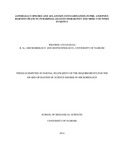| dc.description.abstract | Aflatoxin contamination is a major challenge in peanut (Arachis hypogaea L.) production and trade besides posing health challenges to humans and animals. This study monitored the population of Aspergillus spp. and aflatoxin contamination of peanuts at pre- and post-harvest stages to establish the critical aflatoxin contamination points during peanut production so as to recommend interventions to promote compliance with market standards. Field monitoring was carried out in 40 farms in Meru, Baringo and Elgeyo-Marakwet Counties during the long and short rains of 2013 and 2014, respectively. A semi structured questionnaire was used to obtain information on peanut production practices. Soil was sampled at seedling stage, podding stage, two weeks pre-harvest and at harvest while plant debris was sampled at planting. Below ground peanut parts were sampled at podding stage, two weeks pre-harvest and at harvest. Peanut kernels were sampled two weeks pre-harvest, at harvest, from farmer stores, buyer collection point and at the processing factory after shelling. Aspergillus spp. were isolated from soils, kernels, plant parts and plant debris on modified Dichloran Rose Bengal (MDRB) agar medium and identified to species level. Total aflatoxin in peanut kernels was analyzed by indirect competitive Enzyme Linked Immuno-Sorbent Assay (ELISA). Aflatoxin levels were grouped into three categories based on the standards set by the Kenya Bureau of Standards (KEBS) and the European Commission (EC).
Majority (70%) of the peanut farmers were small scale producers who did not apply soil amendments, practiced mixed cropping and ploughed their fields manually or used animal ploughs. Maize was the main rotation crop with 35% of the farms having maize, only farmers in Meru North and Meru South making 62% of the farms used irrigation with splinkler and furrow being the main irrigation methods. Prevalence of peanut diseases significantly (P ≤ 0.05) varied in the different regions and agro-ecological zones (AEZ) with 40% of the farmers saying they were aware of the recommended method of drying peanuts. However, most (60%) farmers had
xviii
no previous knowledge on aflatoxin and those who did, think it is only a problem in maize. Aspergillus flavus S-strain, A. flavus L-strain, A. parasiticus and A. niger were isolated from soil, crop debris, below ground peanut parts and kernels sampled at various stages pre-and post-harvest. Aspergillus flavus L-strain was the most prevalent fungus in kernel samples from Baringo and Elgeyo-Marakwet Counties with 350 to 4,000 CFU/g kernel whereas A. flavus S-strain was highest in kernel samples from Meru County with 50 to 60,000 CFU/g kernel. Aflatoxin levels varied depending on sampling time with the levels being significantly (p ≤ 0.05) lower in samples taken two weeks before harvest in all the regions during the long rains of 2013. Overall, 80% of kernels sampled from Meru at all stages did not meet the European Commission aflatoxin limit of ≤4 μg/kg while 73% did not meet the KEBS limit of ≤10 μg/kg. All the kernel samples from Baringo Central and Keiyo South were within the safe limits set by the EC and KEBS. There was a positive significant (p ≤ 0.05) correlation between the population of A. flavus S-strain and aflatoxin levels in kernels sampled from Meru County. Although A. flavus L-strain was the dominant fungus in samples from Baringo and Elgeyo-Marakwet Counties, there was no correlation between the population of the A. flavus L-strain and aflatoxin levels. The high population of A. flavus S-strain in peanuts sampled from Meru County implied a health risk to consumers of peanuts because the pathogen produces high amount of aflatoxin especially aflatoxin B1. Dominance of A. flavus S-strain, off season rains during harvesting and challenges in drying peanuts in windrows in Meru County could explain the high aflatoxin contamination of peanuts in the County. It is recommended that a control strategy of the population of major aflatoxin producing Aspergillus spp. and aflatoxin levels be put in place to target critical pre- and post-harvest stages of peanuts. Raising awareness on implications of aflatoxin on trade, human and livestock health and possible management strategies is also recommended.
Key words: Aflatoxin, Aspergillus spp., peanu | en_US |

